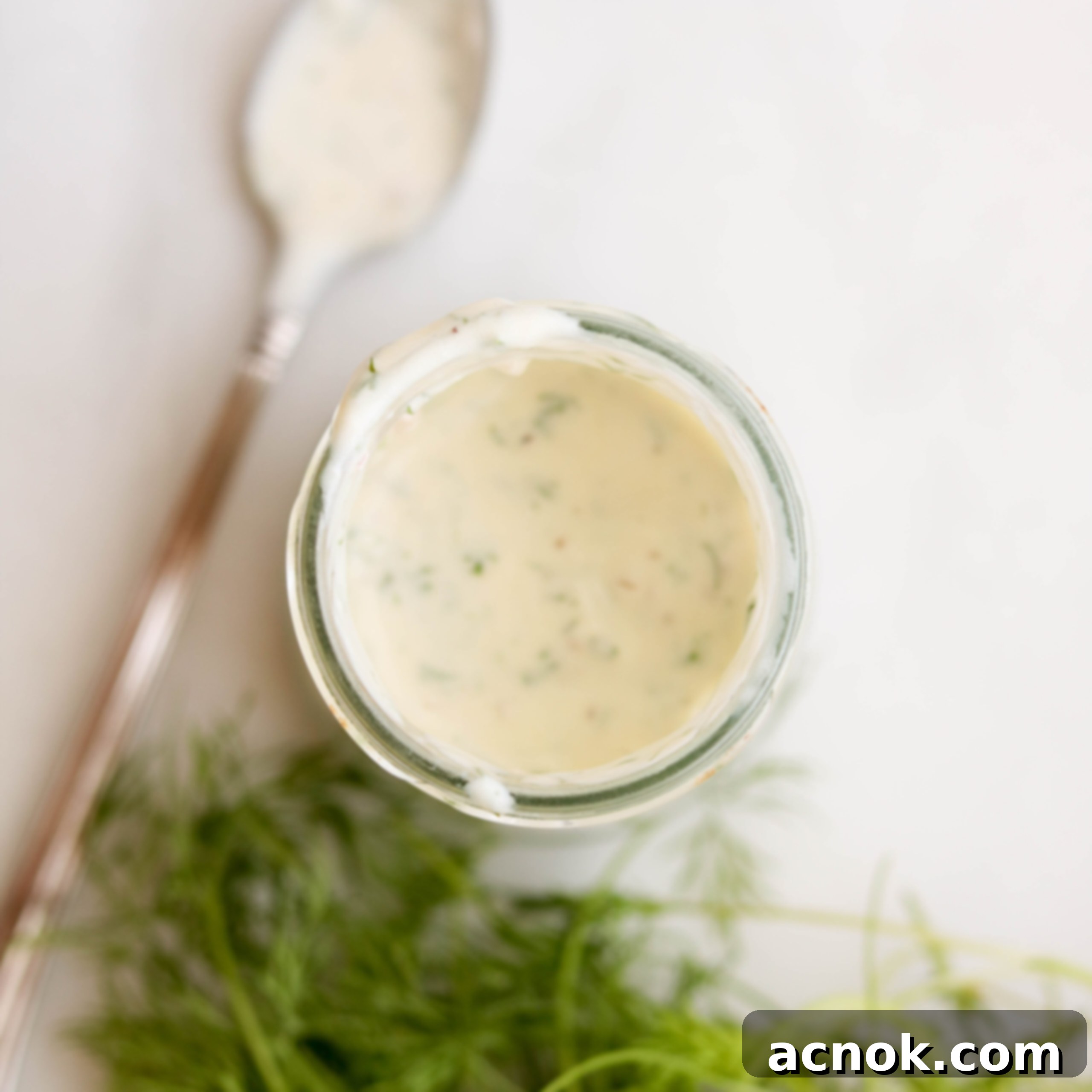Homemade Yogurt Dill Dressing: A Healthy, Creamy, and Versatile Staple
Prepare to elevate your meals with this incredibly delicious and remarkably versatile **Yogurt Dill Dressing**. More than just a simple topping for salads, this creamy concoction doubles as an outstanding dip and a flavorful sauce, transforming everything from grilled lamb and chicken to roasted vegetables and fresh seafood. Crafted with just a handful of easy-to-find ingredients, it’s destined to become a consistent staple in your refrigerator. Its perfect balance of tangy zest and fresh dill flavor will awaken your palate, making every bite a delight. Imagine it as the crowning glory on my Greek Wedge Salad, or as a vibrant accompaniment to countless other dishes.
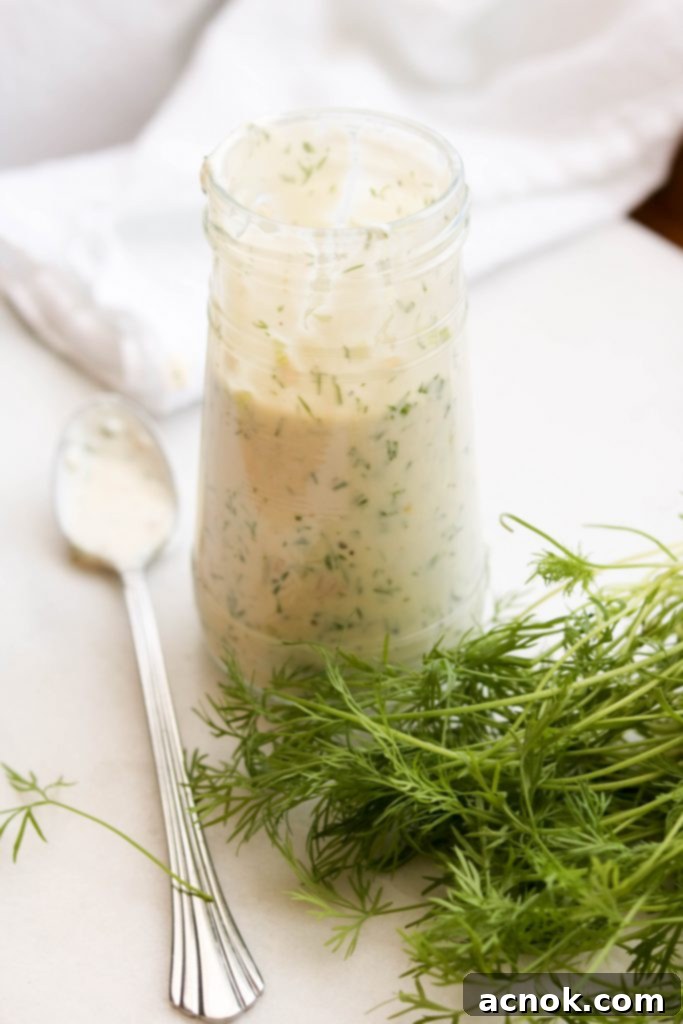
The Inspiration Behind Our Creamy Yogurt Dill Dressing
This exquisite dressing finds its roots in the profound wisdom of one of my absolute favorite culinary resources: Salt Fat Acid Heat by Samin Nosrat. This book isn’t just a collection of recipes; it’s a masterclass in the foundational elements of good cooking. Nosrat’s philosophy centers around understanding the principles of salt, fat, acid, and heat to empower home cooks to create delicious dishes without strict adherence to prescriptive steps. By embracing her approach to mastering techniques, we become more intuitive and confident in the kitchen.
The original “Creamy Herb Dressing” from her book provided the perfect springboard for this adaptation. My goal was to create a dressing that captured the vibrant, fresh essence of her recipe while offering a healthier, lighter profile. Understanding the role of acid from her teachings guided me in selecting red wine vinegar to provide that essential tang, while the natural richness of Greek yogurt perfectly steps in to contribute the “fat” and creamy texture, creating a perfectly emulsified dressing without the need for traditional heavier fats. I wholeheartedly recommend Nosrat’s book to anyone looking to deepen their cooking knowledge, whether you’re a novice or a seasoned chef. Its beautiful illustrations and insightful lessons make it a truly invaluable addition to any kitchen library.
Why Yogurt-Based Dressings Are a Game-Changer for Healthy Eating
While I generally shy away from heavy, creamy dressings, largely due to my preference for simpler vinaigrettes and a dislike for mayonnaise, discovering the power of yogurt completely transformed my perspective. Mayonnaise, often the go-to emulsifier in many cream-based dressings, can be rich and, for some, overpowering. That’s where yogurt, particularly Greek yogurt, steps in as a true culinary hero.
Yogurt brings a multitude of benefits to a dressing. Firstly, it’s naturally lower in fat and calories compared to mayonnaise or sour cream, making it a fantastic choice for those seeking a healthier alternative without compromising on texture or flavor. Secondly, its inherent creaminess and consistency make it an excellent emulsifier, effortlessly binding oil and vinegar into a smooth, cohesive dressing. No more oily separation; just a beautifully blended sauce.
Beyond its culinary attributes, yogurt, especially varieties like Greek yogurt, is packed with gut-friendly probiotics. These beneficial microorganisms are vital for a healthy digestive system, aiding nutrient absorption, and supporting overall well-being. Incorporating probiotic-rich foods into your diet is a simple yet effective way to boost your health from the inside out. So, choosing yogurt as your dressing base isn’t just about taste; it’s a conscious decision for better health.
The beauty of yogurt-based dressings is their incredible adaptability. You can effortlessly create “copycat” versions of almost any creamy dressing by simply substituting yogurt for mayonnaise or sour cream. This simple swap allows you to enjoy your favorite rich flavors while significantly cutting down on calories and increasing the nutritional value. Whether it’s a ranch-style dressing, a creamy Caesar, or a vibrant herb dressing like this one, yogurt opens up a world of lighter, fresher possibilities in your kitchen. Opt for plain Greek yogurt (2% or full-fat for richer texture) to ensure you have a neutral base ready for any flavor profile.
The Art of Homemade Dressings: Healthier, Cheaper, Better
Making dressings at home is one of the easiest and most rewarding culinary skills you can master. It’s a simple act that yields significant benefits, far surpassing the convenience of store-bought alternatives. Firstly, homemade dressings are incredibly cost-effective. A few basic pantry staples and fresh herbs go a long way, saving you money compared to continuously purchasing pre-made bottles.
More importantly, crafting your own dressings gives you complete control over the ingredients. This means you can eliminate all the unnecessary additives, artificial preservatives, high-fructose corn syrup, and excessive sodium often found in commercially produced dressings. Many store-bought options are loaded with “junk” designed purely for shelf stability, not for your health. The peace of mind that comes from knowing exactly what goes into your food, free from hidden sugars and unhealthy oils, is invaluable and makes the few minutes it takes to whisk up a dressing truly worthwhile.
Furthermore, homemade dressings offer unparalleled customization. Once you understand the fundamental components of a basic dressing – typically a balance of fat (oil, yogurt), acid (vinegar, lemon juice), and seasonings (salt, pepper, herbs) – you can experiment endlessly. Want more garlic? Add it. Craving a touch of spice? A pinch of red pepper flakes. Different fresh herbs? Swap them in! This flexibility allows you to tailor flavors precisely to your preferences and to complement specific dishes. Don’t limit yourself to dill; consider basil, parsley, mint, or chives. For more inspiration and a wide array of options, be sure to explore our dedicated Dressings and Sauces page.
How to Make the Perfect Yogurt Dill Dressing: Step-by-Step
Crafting this vibrant Yogurt Dill Dressing is surprisingly straightforward, but a couple of key steps ensure maximum flavor and a beautifully balanced result. The secret lies in allowing the ingredients to properly meld and develop their full potential.
The first crucial step involves the shallots. Finely chopped, they need a little time to marinate, or “macerate,” in the red wine vinegar. This process isn’t just about softening the shallots; it’s about mellowing their pungent raw edge and allowing them to infuse the vinegar with their delicate oniony flavor, creating an aromatic base for the entire dressing. Give them a good 15 minutes – this small act makes a significant difference in the final taste profile, ensuring a smoother, more integrated flavor rather than sharp, raw notes.
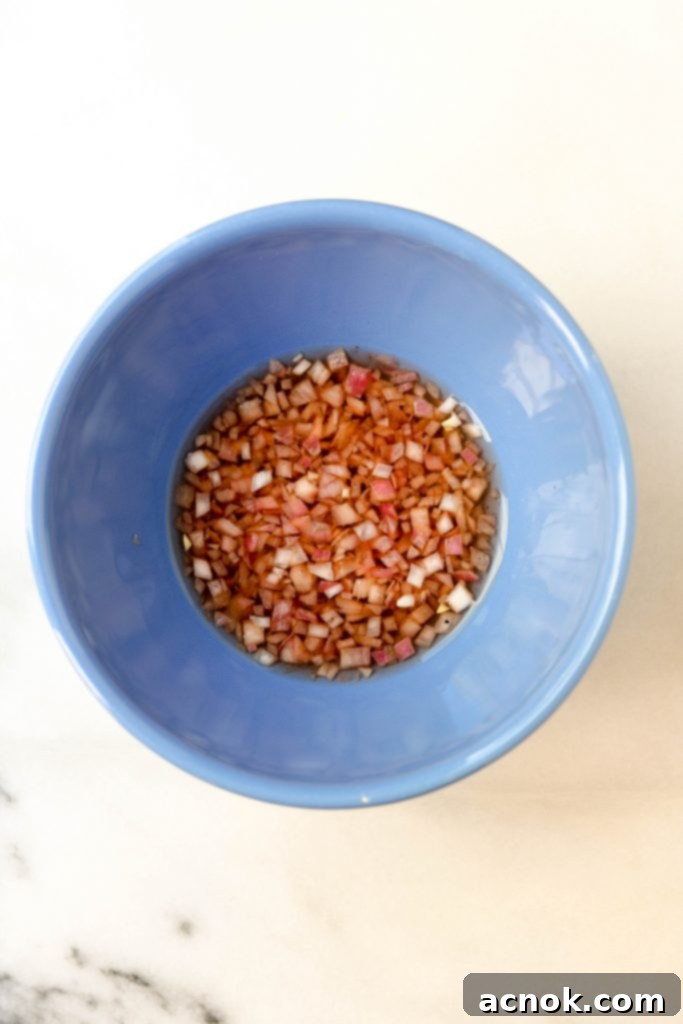
Once your shallots have had their spa day in the vinegar, the rest is simple assembly. Combine all remaining ingredients – the Greek yogurt, extra virgin olive oil, finely grated garlic, fresh green onion, a generous amount of fresh dill, a touch of sugar (to balance the acidity), and an initial amount of salt and freshly ground pepper – in a bowl alongside the macerated shallots and vinegar. Whisk everything thoroughly until it’s completely combined and beautifully smooth. Pay attention to the consistency; it should be creamy but still pourable. Finally, and most importantly, taste it! Adjust the salt, pepper, or even a tiny bit more vinegar if you prefer it tangier, until it sings to your taste buds. Allowing the dressing to chill for an additional 15 minutes after mixing is optional but highly recommended; it provides an extra window for all those wonderful flavors to fully harmonize and deepen, resulting in a more complex and satisfying dressing.
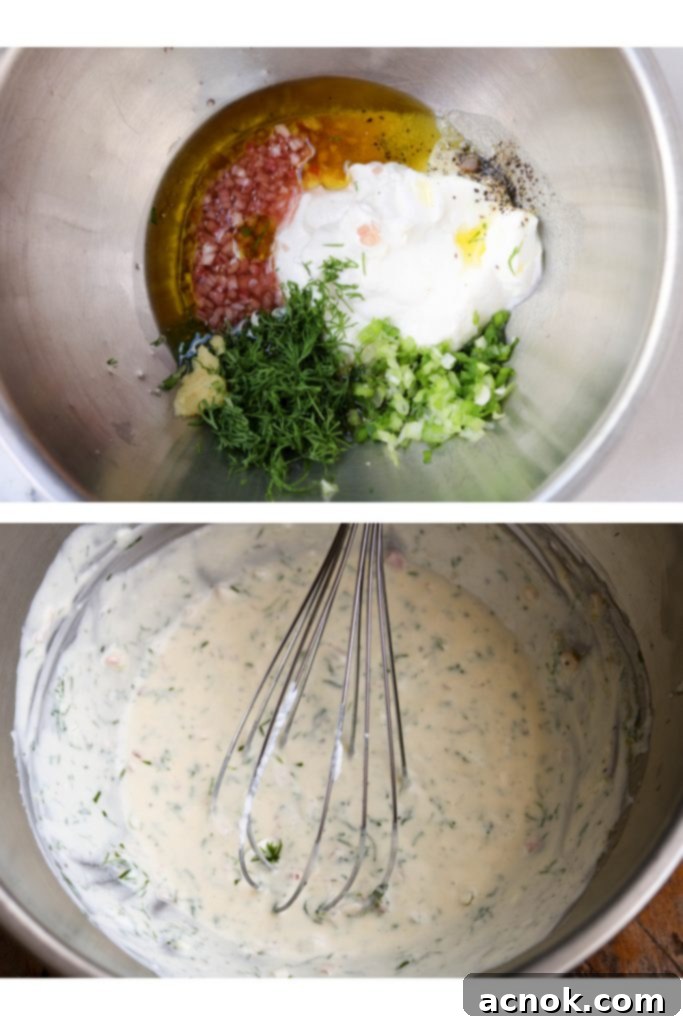
Endless Culinary Possibilities: Suggested Uses for Your Homemade Dill Dressing
The true magic of this Yogurt Dill Dressing lies in its incredible versatility. While it’s a phenomenal partner for my Greek Wedge Salad, its uses extend far beyond a traditional salad topping. Its bright, tangy, and herbaceous profile makes it an ideal complement to a vast array of dishes:
- Salads & Bowls: Beyond classic green salads, drizzle it over grain bowls, roasted vegetable salads, or power bowls for an extra burst of flavor. It’s a perfect match for our Mediterranean Grilled Chicken Bowls.
- Proteins: This creamy dill sauce is exceptional with seafood. Spoon it generously over baked, grilled, or pan-seared salmon, cod, or halibut. It’s also fantastic with poultry – think grilled chicken breasts, succulent chicken skewers, or even as a zesty spread for a turkey burger. For red meat lovers, it provides a refreshing counterpoint to grilled lamb chops or steak.
- Vegetarian Delights: Transform vegetarian meals with this dressing. It makes an incredible sauce for crispy falafel, whether in a pita or on a platter. Drizzle it over roasted vegetables like asparagus, broccoli, or zucchini, or use it to perk up simple steamed green beans.
- Dips & Spreads: Serve it as a healthy dip for fresh-cut vegetables like cucumber, carrots, bell peppers, or radishes. It’s also wonderful with pita bread or crackers. Spread it thinly on sandwiches or wraps instead of mayonnaise for a fresher, tangier kick.
- Quick Meals: One of my favorite quick lunch ideas is to stuff a warm pita bread with a medley of fresh veggies and a generous dollop of this dressing – a perfect, satisfying, and healthy meal in minutes.
- Marinade Component: While not a full marinade on its own, a tablespoon or two can be added to a chicken or fish marinade for an extra layer of moisture and flavor.
Its refreshing qualities cut through richness, while the dill and tang enhance the natural flavors of whatever it accompanies. Don’t be afraid to experiment – you’ll quickly discover countless ways to incorporate this homemade dill dressing into your weekly menu!
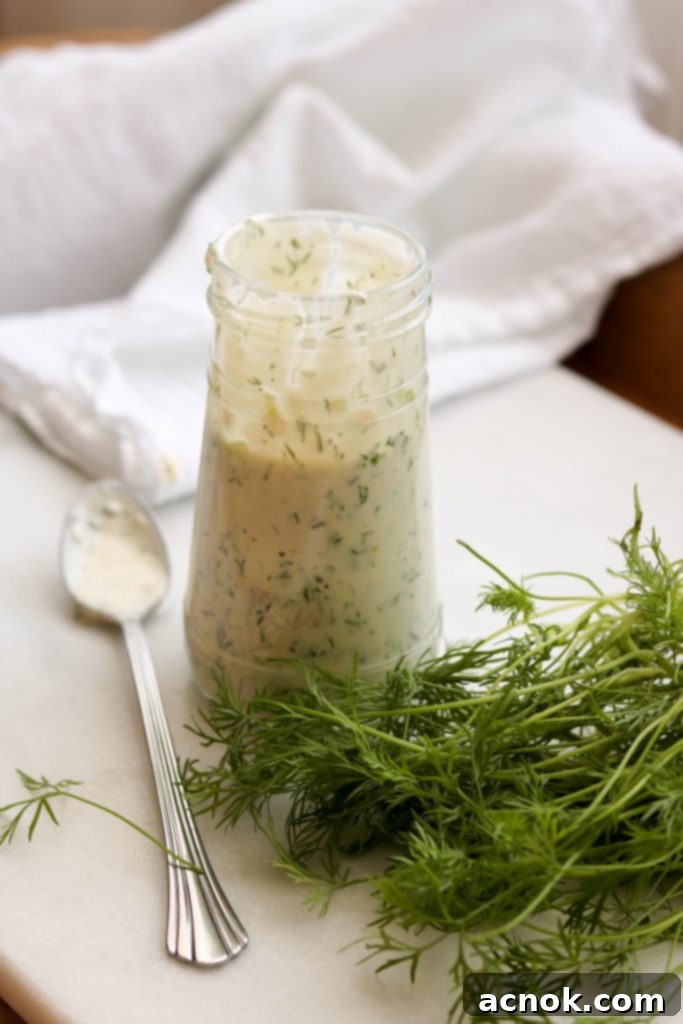
Storage Tips for Your Homemade Yogurt Dill Dressing
Since this homemade Yogurt Dill Dressing contains fresh ingredients and no artificial preservatives, it’s best enjoyed fresh. It will keep beautifully in the refrigerator for about 3 days. This recipe yields approximately 8 tablespoons, which is the perfect amount for one substantial meal for a family, or enough to enjoy across several salads, snacks, and bowls for a couple of days. This small batch size encourages freshness and minimizes waste.
To ensure it stays as fresh as possible, always store your dressing in an airtight jar or container with a tight-fitting lid. This prevents air exposure, which can cause the flavors to degrade and the dressing to spoil more quickly. Before serving, give the container a good shake or a quick whisk to re-emulsify any ingredients that may have separated during storage. This ensures a smooth, consistent texture and an even distribution of flavor every time.
Can I freeze Yogurt Dill Dressing? While technically possible, freezing is not recommended for this dressing. The yogurt base can change texture upon thawing, becoming grainy or watery, and the fresh herbs can lose their vibrant flavor and appearance. It’s truly at its best when enjoyed fresh.
If you’ve tried this delightful homemade Yogurt Dill Dressing recipe, please consider leaving a comment below and sharing some stars! Your feedback helps other readers discover and enjoy this versatile sauce. We 🫶🏼 appreciate you!
All content and photographs ©Claudia’s Table and claudiastable.com
Enjoy!
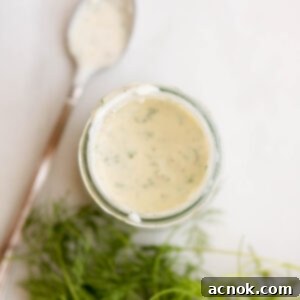
Yogurt Dill Dressing
Ana | Claudia’s Table
May 22, 2020
Pin Recipe
Equipment
-
microplane or garlic press
-
bowl
-
whisk
Ingredients
- 1 tbsp shallots finely chopped
- 2 tbsp red wine vinegar
- 1/2 cup greek yogurt 2%
- 3 tbsp olive oil extra virgin
- 1 clove garlic finely grated with a microplane or finely minced
- 1 green onion/scallion finely chopped
- 3 tbsp dill fresh, finely chopped, leaves only
- 1/2 tsp sugar
- 1/4-1/2 tsp salt kosher
- pepper freshly ground
Instructions
-
Place shallots and vinegar in a bowl and allow to marinade/macerate for 15 minutes.
-
Once the shallots are ready, combine the remainder of the ingredients with shallots and vinegar and whisk until thoroughly combined. Check for salt.
-
Optional: Chill in fridge for about 15 minutes.
-
Keeps for about 3 days in the refrigerator.
Notes
Nutrition
Nutritional information is calculated online and should be used as a guide.
All content and photographs ©Claudia’s Table and claudiastable.com
Check out our New & Delicious posts below
- Pasta with Grilled Vegetables, Feta, and Lemon
- Grilled Asian Marinated Flank Steak
- Classic Homemade Chunky Blue Cheese Dressing
- 3-Ingredient Crispy Oven-Roasted Potatoes
- Grilled Peach Avocado Chicken Salad
